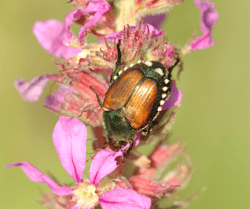Warmer weather is here! Homeowners can look forward to sunny afternoons, budding gardens, and… Japanese beetles? Unfortunately, it’s true. All spring long, Japanese beetle grubs have been working their way to the soil’s surface, getting ready to emerge and pupate into full-grown adult beetles. Come late May, your yard may be overtaken by hundreds of shiny green beetles with voracious appetites. When faced with a sea of yard-destroying and garden-ruining pests, you may wonder: “how do I get rid of Japanese beetles?” EcoShield is here to help.
What are Japanese beetles?
Japanese beetles, or Popillia japonica, are a species of beetle that are native to Japan and were first discovered in the United States in 1916. They are now considered a major pest in many parts of North America, where they feed on the leaves, flowers, and fruit of a wide range of plants. Japanese beetles can now be found throughout much of the eastern United States, from Maine to Georgia and westward to Minnesota, Iowa, and Missouri.
In their native country of Japan, Japanese beetles have natural predators and environmental factors that help keep their population in check. However, in the United States, they have fewer natural predators and have become a significant pest, causing damage to a wide range of plants. Japanese beetles thrive in warm, humid environments and are most active during the summer months when temperatures are high. They often congregate in areas where they can find their preferred host plants, which include roses, linden trees, grapevines, and many others.
Japanese beetles are small insects, typically measuring about ½ inch in length. They have a metallic green body with copper-colored wings and a row of white spots on each side of their abdomen. They are most active during the day and are known to be attracted to plants that are in direct sunlight.
The life cycle of the Japanese beetle includes four stages: egg, larva, pupa, and adult. The eggs are laid in the soil in mid-summer and hatch into small, white grubs. The grubs feed on the roots of grasses and other plants until late fall when they move deeper into the soil to overwinter.
In the spring, the grubs move closer to the surface and continue to feed until they pupate and emerge as adult beetles in early summer. The adult beetles feed on plants for several weeks, mate, and then lay their eggs in the soil to start the cycle anew.
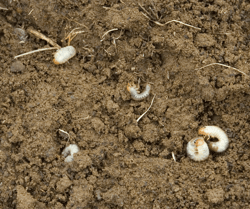 Japanese Beetle grubs in soil
Japanese Beetle grubs in soil
Are Japanese beetles harmful to my home and property?
Yes!
While Japanese beetles can cause significant damage to plants, they are not typically known to cause damage to homes or other structures. However, there are a few ways that Japanese beetles could potentially cause damage to your property:
- Landscaping damage: Japanese beetles feed on the leaves, flowers, and fruit of many plants, including many ornamental trees and shrubs commonly used in landscaping. If your landscaping is heavily infested with Japanese beetles, they can cause significant damage and reduce the aesthetic value of your property.
- Lawn damage: The grubs of Japanese beetles feed on the roots of grasses and other plants in the soil, which can cause damage to lawns and other landscaped areas. If left untreated, a significant infestation of Japanese beetle grubs can kill large patches of grass and make it difficult to maintain a healthy lawn.
- Increased pest activity: If you have a large population of Japanese beetles in your yard, it could attract other pests that feed on the same plants. For example, birds and rodents may be attracted to your yard to feed on the beetles or their larvae, which could lead to other pest problems on your property.
Overall, while Japanese beetles are not typically known to cause direct damage to homes or other structures, they can indirectly impact the appearance and health of your landscaping and lawn, potentially attracting other pests to your property. It's important to take steps to control Japanese beetle populations to prevent significant damage to your plants or lawn. If you have encountered problems with Japanese beetles in the past, we recommend contacting a trusted pest professional to put a pest prevention plan in place to avoid being overrun with Japanese beetles in the future.
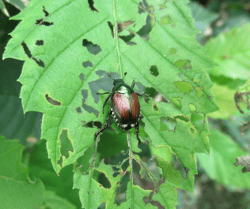 Japanese beetle and damage done to leaves
Japanese beetle and damage done to leaves
Can I prevent Japanese beetles?
Prevention is the best first line of defense against Japanese beetles. Luckily, there are several steps you can take to prevent Japanese beetles from infesting your yard:
- Choose plants that are less attractive to Japanese beetles: Some plants are more resistant to Japanese beetle feeding than others. Consider planting trees, shrubs, and flowers that are less attractive to Japanese beetles, such as cedar, dogwood, lilac, and daffodils.
- Remove potential breeding sites: Japanese beetles lay their eggs in the soil, so removing potential breeding sites can help reduce their population. Consider removing dead or dying plant material, and ensure that your soil is well-drained to discourage egg-laying.
- Use physical barriers: Netting, row covers, and other physical barriers can be used to protect plants from Japanese beetle feeding. Cover plants during peak feeding times, or use netting to create a physical barrier between the beetles and your plants.
- Contact a pest professional to apply insecticides: Insecticides can be effective in controlling Japanese beetle populations, but should be used with caution to avoid harming beneficial insects and pollinators. A reputable pest control provider can apply insecticides where needed and recommend additional prevention methods that can keep Japanese beetles at bay but don’t interfere with beneficial insects and pollinators.
- Maintain a healthy lawn: A healthy lawn can be less attractive to Japanese beetle grubs, and can also help prevent damage from other pests that may be attracted to infested plants. Keep your lawn well-watered and fertilized, and consider using natural or organic lawn care methods to promote healthy growth.
By taking these steps, you can help prevent Japanese beetles from infesting your yard and causing damage to your plants and lawn. For the best prevention and protection, consider enlisting the assistance of an expert pest professional like EcoShield.
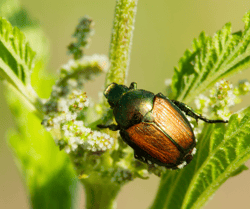
What do I do if my yard is infested with Japanese beetles?
Getting rid of Japanese beetles once an infestation is established can be incredibly difficult. Japanese beetles are known to be stubborn pests due to their lifecycle, lack of natural control and predators, and resistance to some off-the-shelf pest solutions. That said, there are a few methods that can help reduce existing Japanese beetle populations, including:
- Handpicking: One of the most effective and environmentally friendly ways to control Japanese beetles is by handpicking them off your plants. Wear gloves and drop the beetles into a bucket of soapy water to kill them.
- Neem oil: Neem oil is a natural insecticide that can be sprayed on your plants to control Japanese beetles. It works by disrupting the insect's feeding and breeding patterns and can be effective in controlling infestations.
- Beneficial nematodes: Beneficial nematodes are microscopic worms that can be added to your soil to control Japanese beetle grubs. They work by infecting and killing the grubs in the soil and are a natural, non-toxic way to control Japanese beetles.
- Contact the pros: The best option for addressing existing Japanese beetle infestations is to contact a reputable pest professional. With the help of a pest expert, removal of Japanese beetles can be performed effectively while limiting risks to beneficial insects and pollinators, pets, and children. If you have children and pets in your home, we highly recommend that you contact a pet-and-child friendly pest provider specifically to ensure proper precautions are taken.
It's important to note that controlling Japanese beetle populations may require a combination of these methods, as well as ongoing vigilance to prevent new infestations from taking hold. By taking steps to control Japanese beetles in your yard, you can help protect your plants and maintain a healthy landscape. When in doubt, contact a trusted pest professional for help.
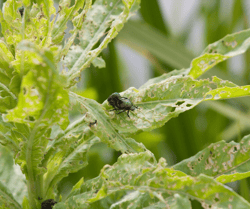 Japanese beetle damage to the lawn
Japanese beetle damage to the lawn
Can EcoShield help with Japanese beetles?
Yes!*
The Shield Home Protection Plan offers four-season protection against a variety of pests and also helps control Japanese beetles outdoors by interrupting their lifecycle and eliminating their ability to achieve adulthood. To learn more about the Home Protection Plan and receive a free no-obligation quote, give us a call or fill out the form on this page today!
*EcoShield can help with Japanese beetles in most US locations. To learn more about Japanese beetle coverage in your area, give us a call.
